mid-day's examination of highly censored, official documuents indicate that 5 airports in the state -- including Mumbai airport are left vulnerable to attacks due to lax security
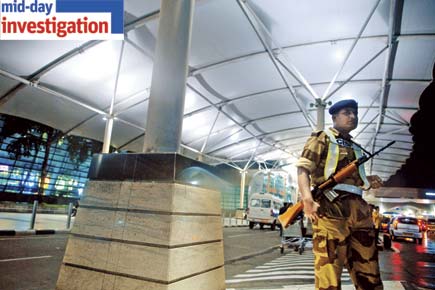
From a layperson’s point of view, our airports seem to be under a heavy cloak of security, but a closer look will reveal that five of Maharashtra’s most sensitive airports, including Chhatrapati Shivaji International Airport (CSIA), are at risk because of an alarmingly lax approach to security.
ADVERTISEMENT
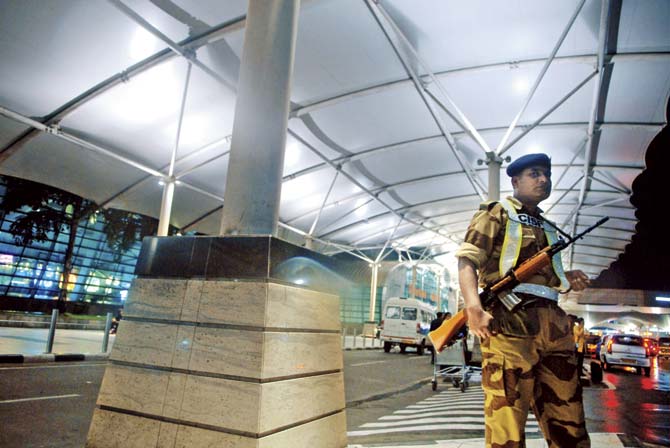
Mumbai airport has had the long-standing issue of poor coordination between security agencies, whether during mock drills or in everyday operations. File pic for representation
A mid-day investigation of highly censored documents from the Ministry of Home Affairs (MHA) suggests these five airports – namely CSIA, Juhu Airport in Mumbai, Dr Babasaheb Ambedkar International Airport (BAIA) in Nagpur, Birsi Airport in Gondia and Chikalthana Airport in Aurangabad – are vulnerable to external and internal threats as a result of a lack of alertness in intelligence agencies, poor contract management of vital security projects, inadequate equipment for security forces, and a whole host of other reasons.
Such lapses are particularly worrying in these five airports because of two major reasons. One, all five are considered sensitive – CSIA and Juhu Airport are located in the state capital, while the remaining three are vulnerable due to the proximity of Naxal presence.
The second factor is that in 2013, an alert was raised when security agencies received intelligence about terrorist plans to attack any one of 24 airports in Maharashtra (that are either inactive or less active), hijack and load a light aircraft with explosives and use it to launch an air strike.
Security audits
Security audits at these airports found them falling short time after time, but the authorities still failed to take action in many cases. For instance, the intrusion detection system at CSIA was deployed after considerable delay but is still below par, and faces major hiccups.
Official reports raise serious questions about internal security, especially at the Gondia and Aurangabad airports, where employees with direct access to the tarmac and the aircrafts do not even go through daily security screenings.
Personnel at the Nagpur airport work with compromised safety, as the authorities have not procured enough bulletproof jackets. Not to mention, except for CSIA, all the airports struggle to maintain adequate manpower in security forces, as their revenue is not enough to cover the costs.
While these are issues that mostly came to light during mock drills, it begs the question, what will happen if there is an actual attack or an emergency takes place and the airports are not ready?
CCTV coverage: Not enough eyes in the sky
While the PIDS is yet to receive any CCTV cameras, the airport premises are watched by 3,000 cameras between gate 1 and gate 5.
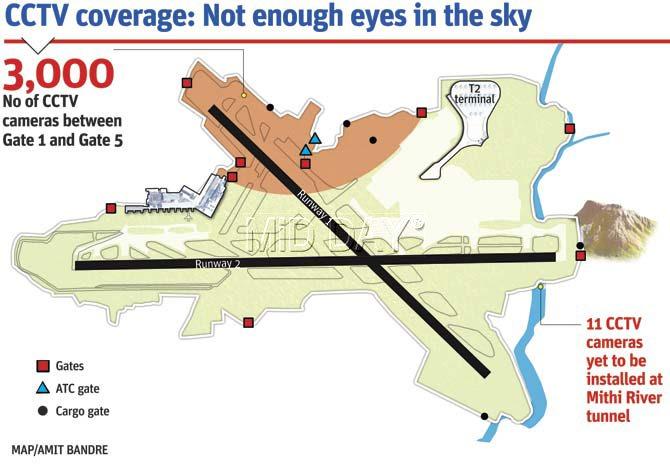
There are proposals to add another 178 cameras at ‘highly sensitive’ zones around the perimeter that remain without surveillance between gates G9, G-9A, G8, CG-32, CG-27, G7, and Gate number 6, but these proposals are yet to be approved.
But a vast tract of land between gates G9, G-9A, G8, CG-32, CG-27, G7, and Gate number 6, is not under camera surveillance. “We have already issued several reminders to the MIAL to install these cameras in the perimeter wall running along these gates, but nothing has been done so far,” said a senior official.
Chhatrapati Shivaji International Airport (CSIA), Mumbai
Mumbai airport has had the long-standing issue of poor coordination between security agencies, whether during mock drills or in everyday operations. But perhaps the most glaring security gap is the new Perimeter Intrusion Detection System (PIDS), a taut wiring project vital for securing the airport periphery.
It took a year of deliberation just to choose the technology, after which the project was kick-started in 2012. The private operator, MIAL (Mumbai International Airport Limited) assured the state that the 10.8-km PIDS project would be completed by the end of May 2013.
The deadline came and went, and 6.8 km of the project was still pending. A Home ministry note warned MIAL, “Now if the contractor does not complete the work within the stipulated time he should be penalized, even as you consent that installation work has been delayed due to some critical issue with the contractor.”
Despite this warning, no action was taken. In a letter to the home ministry in July 2014, MIAL claimed 95% of the PIDS taut wiring was complete and the remaining work would only finish by November, 2014. This final deadline, too, has been breached.
A final observation note from MHA at the end of 2014, rips through this blatant lethargy: “We are dissatisfied with the PIDS work at CSIA, and find it distressing to note that we lost an opportunity to protect ourselves so far because of these issues in the system.”
The MIAL now claims that the taut wire system, fitted with sensors and razors, is complete and has been handed over to the CISF on December 27, 2014. But the CISF confirmed it will only take over the project once the User Acceptance Test (UAT) is completed at the end of this month.
Despite the MIAL’s claims, the system seems to be incomplete - CCTV cameras, attached Pan, Tilt, Zoom (PTZ) controller, integration with an Application Software, wireless LAN, and a Security Operation Control Room (SOCR), are all absent, which means the wiring network will serve for nothing and could lead to a flood of false alarms.
15 kg
The taut wire network sounds an alarm when burdened with a weight of over 15 kg
Lessons from IGI airport, New Delhi
Unlike Indira Gandhi International Airport in New Delhi, which has radar-enabled cameras and buried cables attached to a magnetic field to detect trespassing, CSIA opted for PIDS without these features.
This means that Mumbai airport’s system is already below par, relying on just the taut wire network that sounds an alarm when burdened with a weight of over 15 kg. There aren’t even any cameras to support the system. The MIAL said that delivery of the 102 cameras to be attached to the PIDS has been delayed, but claimed that this does not hinder operations.
Senior security officials who have handled both systems at Delhi and in Mumbai, told mid-day that IGI’s system has failed in the absence of substantial camera coverage, which has led to poor footage quality and increased false alarms. In fact, as many as 1 lakh alarms are generated in a day at IGI, said experts, who worry that the same problems could plague Mumbai as well.
“What happened in Delhi is happening in Mumbai as well; the private operators are in a hurry to dump the incomplete system on the forces. It is essential that the system gets integrated with cameras so as to follow intruders once a breach is reported.
At IGI, we are waging a battle with the private operator who is underplaying the actual number of technical or recurring alarms, estimated to be around a lakh a day. This should not happen in Mumbai,” said a senior CISF official. In Delhi, the CISF suspended a sub-inspector for failing to spot an intrusion that was reportedly not picked up in time by the system either.
In Mumbai, patrol parties and CISF quick response teams (QRTs) confirmed they are currently testing the alarm system by manually pulling the taut wiring at CSIA. They have found that the system is not even responding at many spots. “The taut wiring is not working at several places; we have informed our seniors,” said a CISF patrol-party member at CSIA, Mumbai.
1 lakh
No of recurring alarms generated in a day at IGI airport, New Delhi
Intrusions
So far, the police and CISF have handled two intrusion cases in Mumbai that were in violation of a recent MHA guideline that mandates thorough examination of intrusion cases before letting off the intruders from custody.
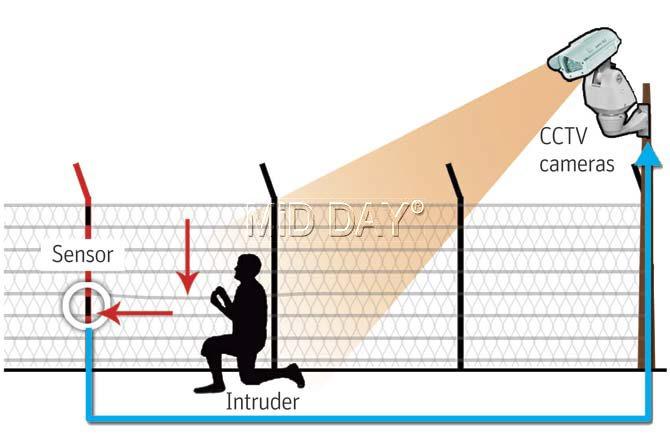
These intrusions were reported on December 29, 2014 and January 1, 2015. In both cases, airport authorities maintain that PIDS managed to raise the alarm. However, patrol parties involved in the arrests on ground, and CISF inspectors present at the control room, confirmed to mid-day that in one of the two cases, the alarm went off exactly a minute after the breach had taken place, while in another, the alarm did not sound at all.
“It was a minute after the intruder breached the wiring that the alarms went off in one of the two cases, in the second, we doubt if the system worked at all,” said a senior member of the patrol team which had apprehended the intruders.
Equally important is the way the cases were handled, however. The CISF declared only one of the two intruders seemed to be of unstable mind, while the police clearly did not agree and handed both intruders over to a mental hospital at Thane.
“Clearly, the police was acting under political pressure and wanted to give these two persons an easy exit without doing a through analysis of their background and intentions. Our investigations show that one of the suspects was not of unstable mind by any stretch of imagination; he claimed to have been upset over not getting married. That didn’t sound convincing to us,” said a CISF official.
The union home ministry in a recent letter to authorities at Mumbai airport has laid clear ground rules in cases of intrusions; directing all agencies to take note, analyze and study intrusion cases seriously and thoroughly: “The CISF and Police must regularly obtain a brief from each other on the status of the intrusion cases; and diligently carry out continuous follow ups.
Such cases must be analysed properly so that they are not repeated as a threat to security,” a recent MHA note reads written at the start of 2014. It is obvious that this brief is ignored.
2
No of intrusions caught by patrol parties at the CSIA in Dec 2014 and Jan 2015
No action taken
Despite several recommendations being made to improve security after the first audit of the airport was carried out between May 7 and May 9, 2012, a detailed survey of sensitive locations and interviews of personnel at CSIA established that the authorities are yet to take any action on the suggestions. “No action and follow ups have been carried out on the IB audit observations yet,” noted an MHA letter from July 2014.
Perimeter Intruder Detection System: How it works
An incomplete system : The Perimeter Intrusion Detection System project was taken on in 2012 by CSIA. Unlike the New Delhi airport, however, Mumbai airport's system does not have radar-enabled cameras or buried cables attached to a magnetic field.
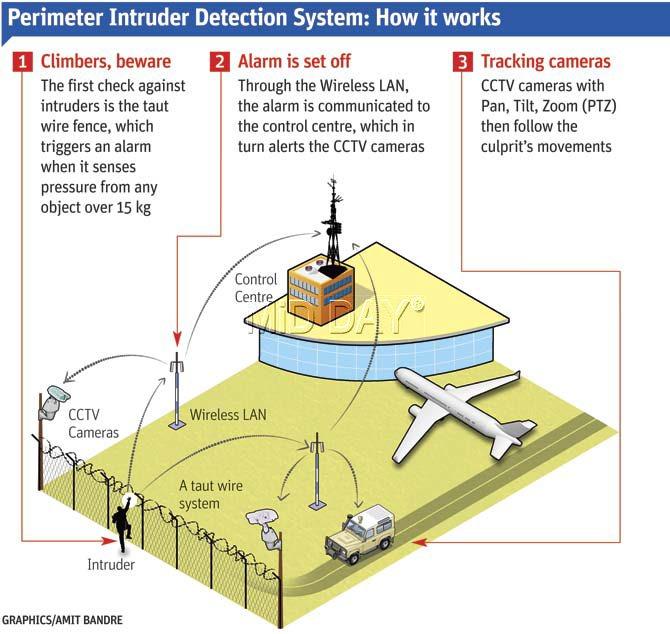
The 10.8-km network of taut wiring is lined with razors as a primary deterrent against trespassers. If that doesn't work, the network is also fitted with sensors that set off alarms during intrusions. 102 cameras are supposed to track the intruder’s movements, but these cameras are yet to be installed. Wireless LAN is absent as well, which means reduced communication between the control centre and the network.
Main components are:
>> A taut wire system
>> Buried cable
>> CCTV cameras, fixed PTZ
>> Application Software
>> Wireless LAN
>> Control Centre
Mock Drills
The boundary issues are just the tip of the iceberg; audit documents show there has been a question mark over the management of mock drills and coordination mechanisms between the various stakeholders: CSIA, MIAL, CISF, NSG (National Security Guard), BCAS (Bureau of Civil Aviation Security), AAI (Airports Authority of India).
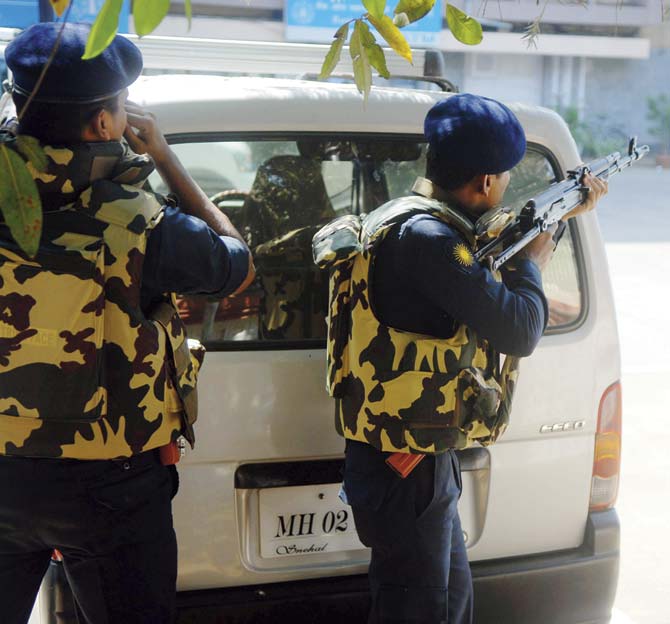
Representational pic
In a recent letter to the civil aviation ministry (mid-day has a copy), BCAS found the mock exercises at CSIA were ‘not realistic, as it was not kept fully under wraps’. The letter noted that most agencies were aware of these exercises in advance, which defeated the entire purpose of preparing the teams for unforeseen emergencies. It also found the drills lacking in professionalism and seriousness.
Audit reports show that heads of several agencies, expected to be a part of these crucial security drills, continuously failed to show up for two years (2013 and 2014). Two counter hijack exercises carried out by the NSG during this period noted poor coordination and grave lapses by agencies.
During a recent drill in 2014, the NSG team asked for parking permission for its aircraft and it was hurriedly given a spot near the International Cargo, instead of the designated hangar of the Air Force, causing a considerable delay in the timing of rescue operations, the audit documents show.
This drill had just come close on the heels of two Aircraft Intervention Exercises carried out on March 25 and June 23, 2013, during which concerns were raised over not having an emergency lane to enable ambulances and fire vehicles to move towards the site of incident without any hindrance. These requirements are yet to be met.
Observations
>> Most agencies were aware of these exercises in advance
>> The drills lacked in professionalism and seriousness
>> Heads of several agencies, expected to be a part of these crucial security drills, continuously failed to show up for two years (2013 and 2014)
IB’s recommendations
>> Urgent security enhancement of sensitive locations around the airport periphery
>> Construction of emergency lanes around the airport perimeter wall
>> Better deployment of forces
>> Installation of CCTV cameras at Mithi tunnel and other sensitive peripheral zones
>> Greater role clarity during anti-hijack, aircraft intervention exercises
>> Speedy implementation of PIDS
Crippled by staff shortage, security forces are under tremendous pressure
Encroachments around the airport boundary walls pose major threat
Encroachment around the boundary wall remains a grave concern. The ministry of home affairs recently wrote to Maharashtra government alerting it about land encroachment outside Mumbai and Nagpur airports. This is now a crucial security threat for CSI airport, and the CISF had assured a 30-foot buffer zone around the outer perimeter wall to allow patrolling on motorway.

Representational pic
“But this buffer too has not been created yet,” reads a note from the home minister. Frequent audits of funnel areas and colonies near CSIA, such as the Hajrat Sayyed Jalal Shah Kadri Dargah atop a hill in Jarimari and other locations such as the Mithi tunnel, are at major risk from aerial strikes.
However, no enhancement work of adding more guards or lights, etc. has been carried. Only two constables stationed on the hill site keep watch on activities. The site remains open to visitors and youngsters can often be seen taking pictures of takeoffs and landings from this point.
Likewise, the MHA audit mandated that the Mithi tunnel passing under the airport be covered with at least 11 CCTV cameras on the entry and exit points. The audit notes that MIAL had assured the home ministry that it would install the cameras immediately, but not a single camera of this lot has been installed yet.
The MIAL had informed the government in July, 2013 that it was looking for an automated censor gate to control Mithi’s stream flow, a technology vital for controlling flooding as well addressing security concerns. The police was also to be briefed on this technology but nothing has taken shape on the ground thus far.
2
No of constables that are stationed on a hill near Jarimari to avert the threat of aerial strikes
11
No of CCTV cameras required to cover the Mithi tunnel passing under the airport
30ft
A buffer zone around the outer perimeter wall that is required to allow patrolling on the motorway
Lax approach
During a recent meeting of the Aerodrome Committee a panel formed for most sensitive airports in the state that meets twice a year members expressed disappointment that ‘‘regular updates on progress on these issues were not being received: encroachment around wall, completion of PIDS, emergency lane for ambulance and fire fighting vehicles, were not happening.”
In another issue, the CSIA continues to manage its anti-hijack check units (XBIS and DFMD) with a team of just three personnel, in a clear violation of the International Civil Aviation Organisation rules that mandate a single check unit with deployment of six personnel including a certified screener; shuffled every 20 minutes to maintain highest level of visual efficiency.
A single check unit includes frisking booth manned by two, one load officer, a certified screener and two female officers. Highly places sources in CISF said the force is short of 650 screeners; and the existing constabulary will take another four years to clear the mandatory AVSEC test and meet the shortage.
“In my letter to government, I have already requested changes to BCAS’ rules, as in Mumbai we are just about managing with three persons on a single unit leading to a lot of risk and pressure on the force,” said a senior commandant. “At the domestic airport we have 24 screening machines, but 50% shortage of staff to manage the same.
This is putting tremendous strain on the existing strength, resulting in poor detection rate,” said a senior CISF official. MIAL security staff clarified while there has been a delay in implementation of various security measures and works, they were largely due to trenching, cabling carried out as per the sight operational plan.
“80% of the delay is due to ongoing trenching and digging works; as far as CCTV goes, we are not rushing as CSIA has a heavy deployment of CISF guarding the perimeter wall; 35 duty posts and nine watch towers doing the work that cameras would essentially do even when installed.
At sensitive locations near Jarimari, the perimeter wall is already as high as 12ft over and above the BCAS limit; we were asked to install a view cutter to block the threat of air strike but this is not a possible option keeping in mind the flight path,” said a MIAL official.
Work in Progress
Chennai-based security advisor of GVK group, DR Kaarthikeyan, told mid-day over the phone: “Security is a work in progress; while we are not at a perfect level for now, we are looking to arrive at a solution to many long-term technical problems as early as possible. A lot has been done at CSIA and to enhance security over the past few years, and the airport remains one of the best maintained terminals in the world.”
650
No of screeners required by the CISF
24
No of screening machines at the domestic airport
Flirting with danger at State airports
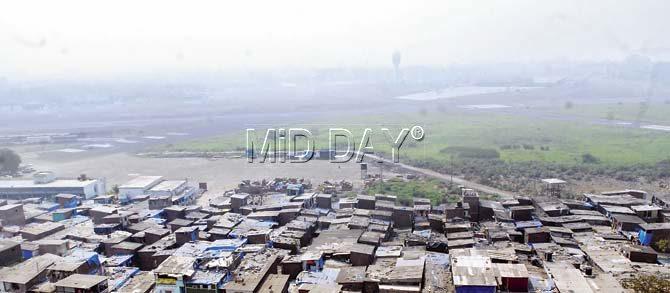
Slums and encroachments plague the Juhu airport. Pic/Shadab Khan
Juhu Airport, Mumbai
>> Built in 1928, this is the country’s oldest airport
>> The airport has been without adequate security blanket since 2009, when AAI and the civil aviation ministry strongly resisted the induction of CISF at the aerodrome due to high costs
>> Three security audits carried out since 2009 have all highlighted grave security lapses at the airstrip
>> Home Ministry demanded twice that CISF be inducted immediately in 2009 and 2013
>> Members of the airport’s Aerodrome Committee, comprising various agencies, wrote a letter in July 2014 urging parties to resolve the issue at the earliest
>> The last red alert at Juhu was given in 2013
>> Currently, AAI has deployed 31 MSGB guards and, in addition, Mumbai Police has deputed 30 officials
>> The state government has agreed to deploy over 52 guards from its corps
>> There are 19 CCTV cameras but only six are working; another 19 cameras are needed
100
The number of helicopter operations handled daily at Juhu aerodrome
Did you know?
India’s first seaplane service was launched at the Juhu Aerodrome in December 2010
Chikalthana Airport, Aurangabad
>> Recent audit reports from the Home Ministry show that families living in proximity to the airport are yet to be profiled by the local police
>> This is a basic aspect of airport security, especially considering the growing encroachment at Mukundwadi, Mhada colony, Prakash Nagar and Ramabai Nagar
>> Aerodrome Committee meetings have cracked down on the local municipal corporation for the past two years for its failure to prevent encroachment
>> During a mock drill last year, important agencies, such as the Intelligence Bureau, did not participate either by choice or because they missed the alarm
>> An audit carried out last year revealed that the CISF frequently neglect carrying out random gate checks at the airport
>> Pilots complain that laser beams, beacons used by party halls in the vicinity affect flight operations
>> Unlawful entry by contract workers and suspects
>> Improvement needed in response time of emergency vehicles
>> Better coordination needed between security agencies
2
The number of times the aerodrome committee meets here every year, supervised directly by the cabinet secretariat, MHA
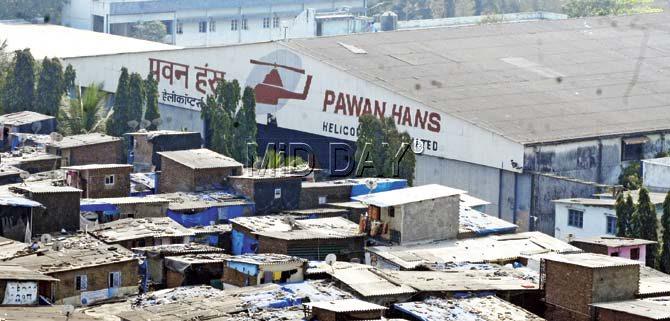
Slums and shanties have surrounded the boundary wall of the Juhu airport. Pic/Shadab Khan
Dr BR Ambedkar International Airport (BAIA), Nagpur
>> Food stalls operate illegally in the approach area to the airport boundary, which is an aviation hazard
>> State directed the local police to carry out checks and ensure the licences of the stalls are cancelled, to no avail
>> Illegal shanties are being built using the airport boundary wall for support
>> In July 2014, private operator Mihan India Limited (MIL) assured it would install additional CCTV cameras in two months, but this is yet to be done
>> The cameras were supposed to ensure complete coverage of the Isolation and Apron bays, which is vital for security
>> Security personnel lack bullet-proof jackets, as neither MIL nor the CISF are willing to make a decision regarding procurement
>> Audits from the past two years show that a counter terrorism contingency plan (CTCP) is yet to be developed due to a slinging match between state police and CISF
>> This contingency plan is a must at Nagpur, as per a June 2006 circular from security agencies
Did you know?
Security gaps at the Nagpur airport were exposed during a mock hijack exercise carried out on July 17, 2014
Birsi Airport, Gondia
>> Birsi airport is under development and is mainly used for conducting training activities
>> The airport has an Anti-Hijacking Control Room (ACHR) with modern communication facilities
>> APSU (Airport Security Unit) is made responsible for Anti-Hijacking, Perimeter Patrolling, and Guarding of Non-Schedule Aircraft and QRT, etc.
>> Total security deployment remains as low as 21 personnel, nearly 45 per cent less than the advisable strength
>> Personnel have not gone through crucial aviation security training as they are usually deployed on temporary basis and are transferred frequently
>> A close analysis of reports of last two years done by mid-day, establishes that the sanctioned manpower here by the AAI must be deployed in view of security arrangements and threat perceptions, not VIP movement. “Not much has changed thus far over the last two years here,” said an AAI official.
>> No vehicles available for the quick response team or the perimeter patrolling team.
>> Security audits have found that boundary protection around the airport is highly inadequate, with just a chain link fence
>> The operational area has several easy access points, leading to a heavy burden on security expenditure
>> Most employees can enter the operational area without getting frisked, even when there are arrangements for Handheld Metal Detectors, and Door Frame Metal Detectors
>> Audits note that no mock drills take place here, and most security agencies don’t have a anti-hijacking plan
>> VIP movement at the airport is in violation of norms laid down by the Bureau of Civil Aviation Security
>> A particular airline’s hangar and a gate near the fire station are vulnerable to threats
Naxal threat
In 2014, the home ministry suggested that the CISF be inducted at Birsi Airport, as it is prone to the Naxalite threat
 Subscribe today by clicking the link and stay updated with the latest news!" Click here!
Subscribe today by clicking the link and stay updated with the latest news!" Click here!






